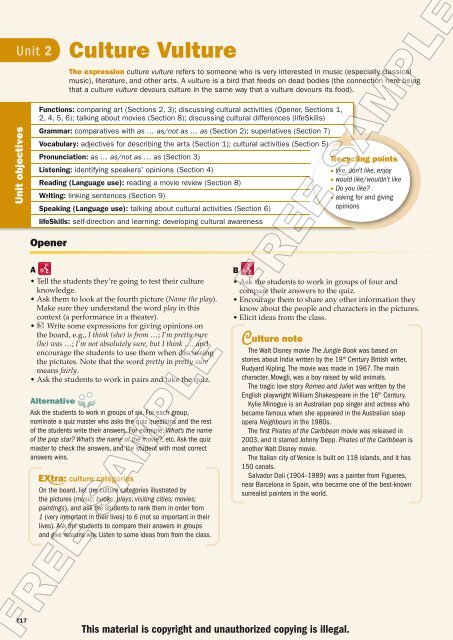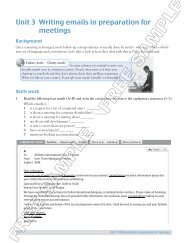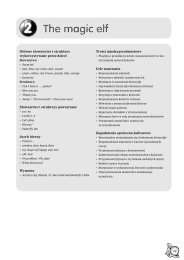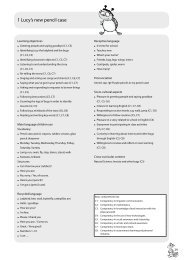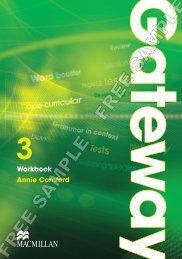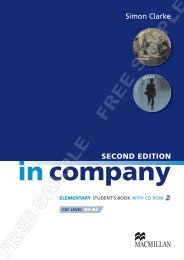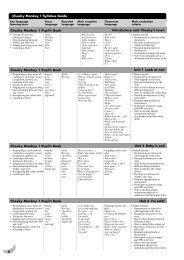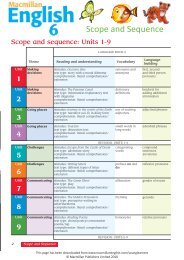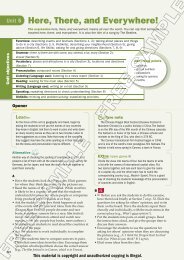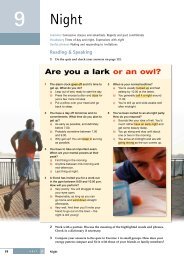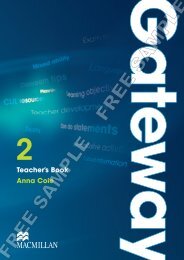Culture - Macmillan
Culture - Macmillan
Culture - Macmillan
Create successful ePaper yourself
Turn your PDF publications into a flip-book with our unique Google optimized e-Paper software.
<strong>Culture</strong> VultureABWork in pairs. Take the culture quiz.Name the pop starKylie MinogueName the characters andthe book they appear inThe Jungle Book. The boy iscalled Mowgli and the bear is Balou.Name the cityVeniceShare your answers with your classmates.What else do you know about the thingsin the pictures?Name the moviePirates of the CaribbeanName the playRomeo and JulietName the artistSalvador DaliUnit 2FREE SAMPLE FREE SAMPLEThis material is copyright and unauthorized copying is illegal.17
1 Vocabulary: adjectives for describing the arts218AMatch the adjectives to their synonyms.Then listen and check.1 silly a) new2 amazing b) dumb3 dull c) inexplicable4 incomprehensible d) very bad5 well-liked e) incredible6 strange f) boring7 terrible g) unusual8 modern h) popularB Complete these sentences with words from Exercise A.1 I think Dali’s paintings are .2 In my opinion, horror movies are .3 Going to the opera is .4 In my country, reality TV shows are .5 Shakespeare’s plays are .C Work in pairs. Compare your sentences from Exercise B.A: In my opinion, horror movies are amazing.B: Really? I think they’re silly.Grammar: comparatives with as … as/not as … asALanguage in context Listen to thisconversation between two friends at a photographyexhibition. Which picture do both women like?Sarah: So, which picture is your favorite?Kate: Well, I love the picture of the flowers. You know, theblack and white one.Sarah: Yeah, I like that one, too, but it isn’t as nice as thepicture of the elephant. That is so cute!Kate: Really? I think it’s as dull as those pictures of a chair. Ididn’t really understand what they were trying to do.Sarah: Maybe we’re just not as smart as everyone else.Kate: Or maybe we just don’t understand art!B Notice Look at the conversation in Exercise A again.Match to complete these rules.We use as … as and not as … as to compare two things.1 We use as … as to … a) say that two thingsare different.2 We use not as … as to … b) say that two things sharea similar characteristic.FREE SAMPLE FREE SAMPLEThis material is copyright and unauthorized copying is illegal.
1 Vocabulary: adjectives for describing the artsLead-in»Think of 6–8 words which are forms of art (they can be wordsfrom this unit or other words you think the students will beable to identify, e.g., theater, photography, music, painting,opera, ballet, sculpture, movies). Write the words on theboard in a scrambled order, e.g., cimus (music); hrattee(theater). Have the students work in pairs to unscramble thewords and write the correct spellings. The first pair to correctlyguess and spell all the words wins.A CD 1, Track 06• See the student’s book page for the audio script .• Read the instructions to the class, and explain thata synonym is a word that has the same meaning asanother word or a very similar meaning to anotherword.• Ask the students to work individually and then tocompare their answers in pairs.• Play the recording for the students to check theiranswers.Lead-in»Ask the students to look at the picture. Invite them to saywhere they think the two women are (in an art gallery, at anexhibition, or in a museum).Ask the students questions about their opinions ofphotography, e.g., Do you prefer paintings or pictures? Why?Do you prefer black and white pictures or color ones? Do youlike abstract pictures? Why or why not?A CD 1, Track 07• See the student’s book page for the audio script .• Play the recording, and ask the students to listenwith their books closed and tell you which pictureboth of the women like. Then ask the students toopen their books.• Play the recording again, and ask the students tocheck their answer. Check the answer with the class.• Highlight that the adjective cute means small,attractive, and easy to like. Babies and young animalsare often described as cute. Remind the students thatsmart means intelligent.<strong>Culture</strong> note2 Grammar: comparatives with as … as/not as … asIn U.S. English, the word dumb has two meanings. It canmean unable to speak, but it also means silly or stupid, as itdoes in this exercise. Note that the b in dumb is silent.B• Explain that there are no correct answers to thisexercise as it just involves the students’ own opinions.• Ask the students to do the exercise individually.Encourage them to use adjectives from both columnsin Ex. A.• Nominate students to read aloud their sentences tothe rest of the class.C• Nominate two students to read aloud the modelconversation. Point out the two ways of expressingyour opinion: I think and In my opinion. Encourage thestudents to use these when they do the task.• Have the students compare their sentences in pairs.Then listen to some of their ideas as a class.Workbook p. 10, Section 1Answerthe picture of the flowersB• Ask the students to work individually to find andunderline examples of as … as and not as ... as in thetext in Ex. A. Have them match the sentence parts tocomplete the rules.• Check the answers with the class.FREE SAMPLE FREE SAMPLEThis material is copyright and unauthorized copying is illegal.T18
C Practice Look at these paintings and complete the sentences with (not) as … as and theadjectives in parentheses.A1 Picture A is as small as (small) Picture D.2 Picture D is not as expensive as (expensive) Picture C.3 Picture A is not as big as (big) Picture B.4 Picture C is not as old as (old) Picture A.5 Picture A is as expensive as (expensive) Picture C.6 Picture B is not as modern as (modern) Picture D.DNow you do it Work in groups. Compare these pictures.1 2 3A: Picture 1 isn’t as nice as Picture 2.B: I agree. It isn’t as interesting.C: I think Picture 1 is as good as Picture 3, and it’s prettier.Pronunciation: as … as/not as … asABListen to these people giving their opinions. Notice that the stress is on the adjective andnot on as … as.I think Spain is as beautiful as Italy.Work in pairs. Practice saying these sentences. Remember not to stress the word as.Listen and check.1 In my country, Latin music is as popular as rock music.2 I don’t think painting is as interesting as taking pictures.3 London is not as big as São Paulo.B4 Many people think that trains are not as comfortable as cars.CWatch out!Martin is as tall as me.Martin is as tall than me.In my opinion, museums aren’t as dull as some people think.FREE SAMPLE FREE SAMPLEThis material is copyright and unauthorized copying is illegal.D3Unit 219
4520Listening: identifying speakers’ opinionsABKey words are important words and phrases that can help to identify a person’s opinion.They can be adjectives or verbs such as like, don’t like, and enjoy. The way a person sounds(bored, interested, etc.) can also indicate what his or her opinion is.Listen to this conversation between two people at a book club meeting. Write W next to theadjectives the woman uses. Write M next to the adjectives the man uses.W interesting M dull W popular M not newListen again and circle the correct answers. How do you know?1 The woman liked / didn’t like the book.2 The man liked / didn’t like the book.CNow listen to five other people talking about books.Circle the correct answers.1 Speaker 1 says she …a) liked a different book more. b) thought the bookwas amazing.2 Speaker 2 thought the book was …a) interesting. b) dull.3 Speaker 3 says he …a) didn’t like the book. b) liked the book.4 Speaker 4 preferred …a) the writer’s first book. b) the writer’ssecond book.5 Speaker 5 says she …a) doesn’t like books very much. b) enjoys reading.Vocabulary: cultural activitiesA Complete the blue circles in these word webs with verbs from the box. Then add one idea of yourown to each word web.learn about take seearchitecturelearn aboutsculpturearta musicalseeThis material is copyright and unauthorized copying is illegal.a foreign moviea comedy showFREE SAMPLE FREE SAMPLE
4 Listening: identifying speakers’ opinionsLead-in»Ask the students what books they like to read. Encouragethem to use like, don’t like, and enjoy. If some students saythey don’t read much, ask them why not. Find out what genresof literature the students know (e.g., romantic fiction, fantasy,science fiction, classical literature).• Give the students time to read the information in theskills box. Ask them to name two aspects that helpus identify the opinion of the person who is speaking(key words like don’t like, and the tone of their voice).• Invite the students to tell you any words or phrasesthey know that introduce an opinion (e.g., I think andIn my opinion).A CD 1, Track 10• Ask the students if they know what a book club is (seethe <strong>Culture</strong> note).<strong>Culture</strong> noteA book club is a group of people who meet regularly todiscuss a book they have all read. They usually meet at thehouse or apartment of one of the members of the group,and it is a social occasion. At the end of the meeting, themembers decide which book to read before the next meeting.• Read the instructions to the class, and explain that forthis task they are only listening for the key adjectives.Play the recording once or twice. Check the answerswith the class.Audio script5 Vocabulary: cultural activitiesLead-in»CD 1, Track 10Woman: OK, so I’d like to talk about one of the mostinteresting books I read all year. My friend bought itfor my birthday and I think you’d all like it. It’s calledThe Art of Looking Sideways by a man called AlanFletcher and apparently it’s very popular …Man: … oh, yeah, I read that, too. It was pretty dull, Ithought. It’s not a new book though, is it? And it’s notreally a book you actually sit down and read.Woman: No, I guess not. It’s more like a collection of picturesand stories and ideas about how to look at the worlddifferently. The writer was a designer and …Remind the students of the value of recording vocabularyin word webs. These can help us to visualize and rememberitems of vocabulary and to remember which words they oftengo (collocate) with (e.g., see a movie, see a comedy show).A• Have the students write each verb from the box in theblue circle of the correct word web. Then have themadd one more word to complete each of the word webs.B CD 1, Track 10• Before you ask the students to listen to the recordingagain, have them read the two statements carefully.• Play the recording once, and check the answers withthe class.• Ask the students which words helped them toidentify the speaker’s opinion and how each personsounded (e.g., the woman used the word interestingand also sounded enthusiastic; the man used theword dull and sounded bored).C CD 1, Track 11• Have the students read through all the statementsindividually. Play the recording once, and checkprogress. If necessary, play the recording again.• Have the students compare their answers in pairs.Check the answers with the class. Encourage thestudents to say which words helped them to identifythe speaker’s opinion, and ask them to describe howeach person sounded.Audio scriptCD 1, Track 111 I thought the book was OK, but it wasn’t as good as SunDancers by Cecily Brown.2 I only read the first 25 pages. It just didn’t interest me.3 Yes, I enjoyed it a lot. It was more exciting than The FlowerGirl.4 It was excellent. I thought it was better than her first book.5 Reading is not something I want to do in my free time. Iprefer painting.homeworkHave the students write about a book they have read forpleasure or as part of an academic program. It can be a bookwhich they either liked or didn’t like. Encourage them to usesome of the adjectives from Section 1.Workbook p. 11, Section 3• Ask them to do the exercise individually and then tocompare their ideas in pairs.• Listen to some ideas the the class.Possible answerslearn about: photography, painting, designsee: a play, a TV showtake: a computer course, a photography classjoin: a sports club, a music clubgo to: the opera, an art galleryFREE SAMPLE FREE SAMPLEThis material is copyright and unauthorized copying is illegal.T20
T21B• Nominate two students to read the modelconversation to the class.• Highlight the use of I’d like to and I wouldn’t like toas more formal versions of I want to and I don’t want to.• Have the students discuss the activities in pairs.Encourage them to give reasons for their choice ofactivities.• Listen to some ideas from the class.AlternativeDo a “find someone who” activity. Write a list of statements likethese on the board:Find someone who …… wants to learn about photography.… would like to join a band.… saw a foreign movie in the past month.… is a member of a club.… goes to the ballet.6 Language use: talking about cultural activitiesLead-in»Ask the students to raise their hands if they ever doquestionnaires. Invite them to tell you what kind ofquestionnaires they do and where they do them (e.g., onlineor in magazines). Do they think that questionnaires giveaccurate interpretations of your knowledge or character? Whyor why not?A• Elicit from the students the meaning of culture vulture(someone who is very interested in music, especiallyclassical music, literature, and other arts). Remindthem that the verb belong to means to be a member of inthis context.• Ask the students to do this exercise individually andthen to calculate their score. Find out which membersof the class are real culture vultures!• Highlight the fact that a music group is like a bookclub and that it is a music appreciation club ratherthan a band. Point out that the final –t in the wordballet is silent in English. It is pronounced /ˈbælei/.AlternativeAsk the students to work in pairs and use the questionnaire tointerview each other. Remind them to use Do you for #1 and #2and Did you for #3. Then ask them to calculate their partner’s scoreand read aloud the interpretation for it.Ask the students to copy them into their notebooks. If necessary,elicit the questions they will need to ask for each statement (e.g.,Do you want to learn about photography? Do you enjoy goingto the ballet?). Have them circulate and ask questions to otherclassmates until they find someone who answers Yes to a question.They should then write that person’s name next to the statement.When the students finish, conduct a brief feedback session withthe class.Workbook p. 12, Section 4B• Ask the students to work in groups of three.• Tell them to read the model conversation aloud, witheach member of the group taking one of the roles,A, B, or C. Encourage them to discuss their culturalactivities in a similar way.C• Give the students a couple of minutes to summarizethe general opinion of their group about whichactivities are popular and which are not so popular.• Encourage the students to report back to the rest ofthe class, using as … as and not as … as.culture questionnaireAsk the students to design their own culture questionnaire,using the vocabulary from both vocabulary sections. Theirquestionnaire can follow a similar format to the one inEx. A, or it could use other types of questions, such asmultiple choice or true/false statements. Encouragethe students to design a scoring system and to writeinterpretations of the different scores.FREE SAMPLE FREE SAMPLEThis material is copyright and unauthorized copying is illegal.
a cooking classBWork in pairs. Say which of the activities in Exercise A you would like to do and which you wouldnot like to do. Give reasons.A: I’d like to join a book club. I love reading books and talking about them.B: I wouldn’t like to join a book club. I think reading is boring. I want to take another language course.I’d like to learn Russian.Language use: talking about cultural activitiesA Complete this questionnaire.BCI like …takeFind out with our questionnaire. Simply check the boxes that apply to you.■ going to the theater.■ seeing comedy shows.■ going to the ballet.■ going to art exhibitions.■ learning about architecture.I belong to …a language course■ an art club.■ a book club.■ a language class.■ a music group.an art classa museuman exhibitionthe balletgo toLast year I …Work in groups. Compare your answers to Exercise A. Discuss any other culturalactivities that you enjoy.A: So, do you like going to the theater?B: Yes, I do. What about you?C: Oh, I don’t like going to the theater, but I enjoy going to the movies.a band■ went to a museum.■ saw a foreign movie.■ went to the theater.Score one point for each box you checked.Score 0–3: Cultural activities are definitely not for you!Score 4–8: Why not try some different cultural activities?Score 9–12: You’re a real <strong>Culture</strong> Vulture!Tell the class about the activities that are popular in your group and the ones thataren’t so popular.In our group, going to the theater is as popular as seeing comedy shows. Art clubs are not as popularas music groups.joina book cluba photography clubFREE SAMPLE FREE SAMPLEThis material is copyright and unauthorized copying is illegal.6Unit 221
7 Grammar: superlatives22AA Language in context Read these opinions. Which speakers give a positive opinion and whichgive a negative opinion?B Notice Look at Exercise A again and complete this table.C Practice Complete these sentences with the superlative form of the adjective in parentheses.1 In my opinion, The Simpsons is the most fun ( fun) cartoon ever!2 Luciano Pavarotti was the greatest ( great) singer I’ve ever heard.3 Taking a class is one of the best ( good) ways to meet new people.4 The least interesting ( interesting) shows on TV are animal shows.5 The funniest ( funny) movie that I ever saw was The Mask with Jim Carrey.6 Marilyn Monroe was the most beautiful ( beautiful) cultural icon of the 1950s.7 I think hip-hop is the worst ( bad) type of music. I hate it!8 Justin Timberlake’s new album is the hottest ( hot) CD of the year.D“In my opinion,the scariest movie of alltime is The Ring.”One syllable adjectivesTwo syllable adjectivesending in –yAdjectives with two ormore syllablesIrregular adjectivesFor most, add –est:Now you do it Choose one of these topics. Tell a partner one or two details about it.• the funniest TV show • the best group in concert • the most popular singer in your countryA: The funniest TV show is The Offi ce. I really like the actors.B: Really? I think the funniest TV show is …e.g., old—oldest, dull—dullest, new—newestFor adjectives which end consonant–vowel–consonant, double the fi nalconsonant and add –est:e.g., thin—thinnest, fat—fattest, hot—(1)Change the y to i and add –est:e.g., happy—happiest, easy—easiest, scary—(2)Use most or least:e.g., important—most important, interesting—least interesting,popular—(3)most populare.g., good—best, bad—(4)Some short adjectives such as fun and real are used withleast/most and not –est:e.g., Concerts are the most fun in the summer.B“Elephunk by The Black EyedPeas is the hottest album ofthe last ten years.”Cworst“The worst show right nowis America’s Top Model. I can’tbelieve it’s one of the mostpopular shows.”Use the before superlatives:e.g., It’s the scariest movie.It’s one of the most popular shows.This material is copyright and unauthorized copying is illegal.hottestscariestWatch out!He’s the thinnest man.He’s the more thin man.FREE SAMPLE FREE SAMPLE
7 Grammar: superlativesLead-in»Ask the students to think about their favorite movie, album,and TV show, and also a movie, album, and TV show theydon’t like. Tell them to compare their likes and dislikes inpairs and find out if they have any similar opinions. Listen tosome of their ideas as a class. Find out how many studentslike and dislike the same movies, albums, and TV shows.A• Have the students read the question and do the taskindividually.• When the students finish reading, check the answerswith the class. Discuss with the students if they likeor dislike The Ring, The Black Eyed Peas, and America’sTop Model.• Highlight that in Opinion B, hot in this sense meansexciting and new rather than hot as the opposite of cold.AnswersA positive B positive C negativeB• Ask the students to work individually to completethe grammar table with words from Ex. A. Have thestudents compare their answers in pairs, then checkthe answers with the class.• Focus on the rules in the grammar table. First, invitethe students to tell you the superlative forms of theseone-syllable adjectives: long, short, young, new, andcold (longest, shortest, etc.). Then focus on one-syllableadjectives ending in consonant-vowel-consonant, andemphasize that the final consonant is doubled. Askthe students to spell the superlative forms of big, sad,and wet (biggest, saddest, wettest).• Highlight that the final consonant is not doubled onone-syllable adjectives ending in consonant-vowelconsonantwhen the final consonant is –w, e.g.,low–lowest.• Point out that there are not many two-syllableadjectives ending in –y. Apart from the examplesgiven in the table, common ones are funny, messy, andlucky. Invite the students to tell you the superlativeforms of these and spell them (funniest, messiest,luckiest).• Point out that least is the opposite of most and is usedwith adjectives with two or more syllables, e.g., themost popular movie, the least popular movie.• Highlight that there are very few irregularsuperlatives. Apart from best and worst, the only othercommon one is furthest (far).• Draw the students’ attention to the language boxbelow the table, on the right. Point out that thedefinite article the is always used before superlativeadjectives in English: the biggest, the most important,the best.• Point out that one syllable adjectives ending in –eonly add –st, e.g., latest, nicest.• Ask the students to look at the language box belowthe table, on the left. Emphasize that these twoexamples of one-syllable adjectives are exceptions.Most one-syllable adjectives follow the rule outlinedin the table.C• Draw the students’ attention to the Watch out! box.Remind them that they need to use the –est ending toform superlatives of one-syllable adjectives.• Ask the students to do this exercise individually andthen to compare their answers in pairs. Check theanswers with the class.<strong>Culture</strong> noteA cultural icon is an image, a person, a building, or a productthat most people from around the world recognize and thatsymbolizes a particular country or culture. Examples ofcultural icons are the Statue of Liberty, Mickey Mouse, andMarilyn Monroe.D• Give the students a few minutes to choose one of thetopics and to make notes about their opinion.• Ask them to read the model conversation. Have themwork in pairs to tell their partner about the topic theychose.• When they finish, listen to some ideas from the class.AlternativeDo this as a pyramid exercise. First, tell the students to workindividually to decide on the funniest TV show, the best group inconcert, and the most popular singer. Then have them work in pairsto agree on a single set of answers for both of them. Each pairthen joins another pair to form a group of four, all of whom have toagree on a single set of answers for the group.Ask the groups to report back to the class. Take a vote to find outthe funniest show, the best group, and the most popular singer.guessing gameAsk the students to think of five culture-related categories(similar to the ones in Ex. A) using superlatives (e.g., the bestmovie, the worst singer, the most beautiful city). Have themwrite their answer for each one. In pairs, have the students readaloud their answers. Their partner has to guess the category foreach answer, e.g., A: You think The Matrix is the worst movie.B: No, I think it’s the best movie. The winner is the student whoguesses the most answers within a set time limit.Workbook p. 12, Section 5FREE SAMPLE FREE SAMPLEThis material is copyright and unauthorized copying is illegal.T22
T238 Language use: reading a movie reviewLead-in»Write the phrase movie review on the board. Have thestudents tell you what it means (an article which gives anopinion about a movie). Ask them if they ever read reviewsbefore they go to a movie. Do these reviews influence theirchoice?A• Before you have the students read the review, askthem to read the question. Tell them that, as theyread, they should underline words or phrases thatwould help them to answer the question (e.g., favorite,funny, more laughs, you’ll love it).• Check the answer with the class. Encourage them tosupport their answer with examples from the text.Answeryes9 Writing: linking sentencesLead-in»Write two short sentences on the board, e.g., We stayed athome. It was raining. Ask the students to work in pairs anddiscuss how they could join these two sentences to make onelogical sentence. As a class, elicit the sentence: We stayed athome because it was raining.Then repeat the exercise with the two sentences in theopposite order: It was raining. We stayed at home. Elicit thesentence It was raining, so we stayed at home.• Give the students time to read the informationin the skills box. Ask them to tell you what kindof information because introduces (a reason forsomething) and what kind of information sointroduces (the result of something). Elicit why it is agood idea to use these words when writing (becausethey allow you to form longer sentences, which canmake your writing more interesting).A• Check that the students know what a cultural icon is(see the <strong>Culture</strong> note in Section 7). Tell them to ignorethe because/so choices in the text for now. Ask them tocomplete the task individually and then to comparetheir answer in pairs.• Check the answer with the class. Encourage thestudents to say which words or phrases helped themto identify the cultural icon.WorkbookOver to you – p. 14 mindStrategy – p. 15B• Give the students two or three minutes to writesome notes about a good and a bad movie they sawrecently. Before they do the task in pairs, refer themto the example sentences, and encourage them to usesuperlatives when talking about their movies.• When they finish discussing their movies, listen tosome ideas from the class. Correct any errors in theuse of superlatives.homeworkAsk the students to write their own movie review athome, using the review in Ex. A as a model and includingsuperlatives. In the next class, display the reviews and havethe students read them. Tell them to decide which movie theywould like to see. Elicit some of the students’ movie choicesat the end of the class, and discuss why.AnswerCoca Cola®B• Ask the students to complete the task individuallyand then compare their answers in pairs. Check theanswers with the class.C• Ask the students to do this task individually. Whilethey are writing, circulate and monitor their work.When they finish, check the answers with the class.• Highlight that the clause beginning with because caneither come second in the sentence (as in #1) or at thebeginning (as in #4). Clauses that use so to describe aresult or consequence cannot normally be used at thebeginning of the sentence.discussionCoca Cola® is a U.S. cultural icon. Ask the students to work insmall groups and think of more cultural icons they associatewith different countries, including their own. If the students arehaving difficulty thinking of examples, write a few countrieson the board to give them ideas, e.g., France, Italy, China, theU.K. Examples of cultural icons associated with these countriesmight include: the Eiffel Tower, pizza, the Great Wall, doubledeckerbuses. Listen to their ideas as a class.Workbook p. 13, Section 6FREE SAMPLE FREE SAMPLEThis material is copyright and unauthorized copying is illegal.
Language use: reading a movie reviewA Read this movie review. Did the writer enjoy The Simpsons Movie?BThe Simpsons Movie has to be one of my top five favoritemovies of all time. I love it because it’s as funny as thecartoons, but it’s 85 minutes long—so there are lots morelaughs! The funniest part of the movie for me is whenHomer takes a pig home from a restaurant. He calls himSpiderpig and loves him more than he loves his kids—Bart,Lisa, and Maggie! Maggie is the youngest of the Simpsonchildren and she never speaks in the cartoons. However,right at the end of the movie, Maggie says her first “real”word. Go see the movie and find out what she says!I promise you’ll love it!Sean Green, Ontario, CanadaThink about two movies that you saw recently: one good and one bad. Tell a partner about thebest and worst parts of these movies.Recently, I saw … The best part was when …The worst part of the movie was when …Writing: linking sentencesWe use the words so and because to link ideas. They are useful because they make your ideasclearer and more interesting for the reader. Because is used to introduce the reason forsomething and so is used to introduce the result of something.A Read this description. Which famous cultural icon does it describe?It was first invented in 1886 by Dr. John Pemberton in a pharmacy in Atlanta, Georgia (1) because / so hewanted to make a “health drink.” Pemberton said that it was good for people’s health (2) because / so it wasmade from sparkling water. Frank Robinson, who worked for Pemberton, created the logo that is famoustoday. Pemberton sold the drink in his store for the very cheap price of five cents a glass, (3) because / so itbecame very popular very quickly. By 1887, the business was too big for Pemberton, (4) because / so he soldpart of the company to a businessman called Asa Griggs Candler. Candler started the company as we knowit today. In 1985, the company started selling a new version of the drink, but changed the flavor back to theoriginal after three months (5) because / so people didn’t like it.B Read the text in Exercise A again and circle the correct linking words.C Connect these ideas using so or because.1 Potato chips are one of the most popular snacks because they are cheap and tasty.2 I think cornflakes taste horrible, so I never eat them.3 I don’t drink cola, so I don’t know what it tastes like.4 Because potato chips are fried, they aren’t very healthy.5 I love sweet drinks, so I always put sugar in my coffee.FREE SAMPLE FREE SAMPLEThis material is copyright and unauthorized copying is illegal.89Unit 223
lifeSkills24Self-direction and learning:developing cultural awareness• Keep an open mind.• Identify differences with respect to your own culture.• Think of reasons for these differences.ALook at these pictures. Which one shows the way you usually greet your friends?Tell a partner.When I greet a friend, I usually hug him or her.B Read this article about personal space. Which of the facts surprises you the most?Personal space is an invisible area around you.If someone enters this space when they are talking toyou, you might feel nervous or uncomfortable. Peoplehave different attitudes towards personal space: somepeople like more space than others. How close youstand to someone else when you are talking to themdepends on who it is you are talking to and thesituation. Also, how close you can go is differentin different cultures.Here are some interesting facts aboutdifferent cultures and personal space:• In Latin American and Arabic countries,people feel comfortable standing close toothers while waiting in line at the bank or atthe supermarket. It’s also common for peopleto sit close to each other in public places suchas the subway or the bus. People in NorthEuropean and Japanese cultures aren’t ascomfortable with this.• North Americans like to have the largest amountof personal space. As a result, they often live inbigger homes with bigger rooms than Europeans.• People from Mediterranean countries such asFrance, Greece, and Italy are more likely to kissfamily and friends when they meet. They are alsomore likely to live most of their lives in the sameneighborhood.• Australians who live in towns and cities don’tneed as much personal space as Australianswho live out in the desert.FREE SAMPLE FREE SAMPLEThis material is copyright and unauthorized copying is illegal.
Self-direction and learning: developing cultural awarenessThe lifeSkills section has a two-tiered design which includes a linguistic focus and a soft skills focus.The aim of the first is to recycle and consolidate the target language of the unit, and the aim of thesecond is to expose the students to vital soft skills that will enable them to become more competitiveand successful in their academic and professional lives.When you teach the lifeSkills section, you may decide to draw attention to the bulleted steps atthe start of the section which break down the soft skill. It is important to remember that the skillsdeveloped in this section can be applied in contexts beyond the English classroom. However, if youprefer to teach the section without discussing the underlying soft skill, this is also possible. Thesection is designed to be engaging and successful either way.Self-direction and learning: developing cultural awarenessStep 1 Keep an open mind. (Ex. A, Ex. B)Step 2 Identify differences with respect to your own culture. (Ex. C)Step 3 Think of reasons for these differences. (Ex. D, Ex. E)The following are some ideas for how to highlight the soft skill. You may choose to do one or several ofthese at the beginning of the lesson, at the end, or as you go through the exercises in the section. Yourapproach to the lifeSkills section may vary depending on your class and the unit.• Read the target skill aloud and highlight the three-step strategy to develop the skill. Check that thestudents understand all the vocabulary.• Relate each exercise in the lifeSkills section to the relevant stage in the three-step strategy beforeyou ask the students to begin the exercise (e.g., The aim of this exercise is to identify differences withrespect to your own culture. This is Step 2 in the three-step strategy.).• When the students finish all the exercises, ask them to read the Reflect statement and questions.Encourage them to tell you what they have learned or practiced in this section and where and how theycan apply the strategies outside the classroom. Emphasize the steps they’ve explored and practiced.Lead-in»Ask the students what they understand by the term culturalawareness. If necessary, explain that it means knowing thatpeople from other cultures do things differently from you, andunderstanding and respecting these differences. Explain thatthe word awareness means knowledge or understanding of aparticular subject or situation.Emphasize that in order to be culturally aware, it is importantto understand not just the differences between cultures, butthe reasons for those differences.A• Refer the students to the pictures, and encouragethem to think about how they usually greet theirfriends. Draw their attention to the example sentence.• Ask the students to work in pairs to compare theirway of greeting their friends. You may need to givethe students the expression shake hands.• Listen to some ideas from the class.greetingsDiscuss ways of greeting different people in the students’own country, e.g., friends and family, classmates and workcolleagues, people with a high status, someone they aremeeting for the first time. Ask them what they do when theygreet different types of people, e.g., kiss, shake hands, wave,hug (when you put your arms around someone, but do notkiss them).<strong>Culture</strong> noteIn the U.S. and other English-speaking countries, it is normalto shake hands when you are first introduced to someone,especially in a business context. Women often hug or kissclose friends when they meet them, but men don’t usually dothis. People don’t usually shake hands or kiss their colleagueswhen arriving at work, which is the custom in some countries,e.g., France.B• Draw the students’ attention to the title of the article:Personal Space. Tell them to quickly read the article tofind the definition of personal space (an invisible areaaround you).• Ask them to read the article again and underline anysurprising facts about personal space in differentcultures. Have them discuss what they found in pairsand decide which fact was the most surprising.• Listen to some ideas from the class.FREE SAMPLE FREE SAMPLEThis material is copyright and unauthorized copying is illegal.T24
T25C• Draw the students’ attention to the phrases in theHow to say it box. Encourage them to use these phraseswhen they are discussing the article in pairs.• Ask them to think about the cultural practicesmentioned in the text in Ex. B. Have them work inpairs to decide which of these practices are the sameor similar in their country and which are different.• Elicit some ideas from the class.vocabularyAsk the students to work in pairs and look at the article inEx. B again. Tell them to identify any words or phrases theydon’t know and would like to understand, and write themon the board. Words you may need to explain includecomfortable/uncomfortable (physically relaxed/not physicallyrelaxed), attitude (your opinion or feeling about something)close (another word for near), amount (quantity), likely(probable), and desert (give an example, e.g. the Sahara).D• Ask the students to read the question and answerit individually. Tell them to use the ideas suggestedby the three people in the pictures, but also to addsome ideas of their own. If they need further help,write some prompts on the board, e.g., religion? size ofcountry? type of neighborhood?• Ask the students to make notes, as they will need toshare their ideas in Ex. E.E• Divide the class into groups of four or five. Ask thestudents to look at the phrases in the How to say it box,and encourage them to report back in this way.• When the students finish, ask each group to chooseone person to report back to the whole class on thelist their group has made. Listen to some ideas fromthe class.• At the end of the discussion, remind the studentsthat it is very difficult for scientists and academicsto measure cultural differences and to give specificreasons why people from different cultures behavein different ways. It may simply be that there area number of different factors—including our owndifferent personalities—that make us behave the waywe do.Reflect• Give the students time to read the Reflect statementand questions. Encourage them to think of timeswhen they have interacted with foreigners in theircity/country, or visited a foreign country, or evenseen a foreign movie, and to say what culturaldifferences they noticed. You may need to providesome examples here to prompt the students. If youhave any personal anecdotes involving culturaldifferences, this might be a good time to share them.• Encourage the students to consider culturaldifferences in different areas, such as the roles ofmen and women (whether men help at home withthe cleaning and cooking, for example), meal timesand going out (for example, in Spain people go outat 11 p.m., whereas in the U.S. they go out at 7 p.m.),waiting in line in banks, shops, and at bus stops, andeating habits (for example, certain foods they enjoymight be forbidden in other cultures).• Encourage the students to think of reasons forthese differences.• Make the students realize that being culturally awareinvolves not only identifying, trying to understand,and respecting differences in other cultures, but alsobeing aware of how your own culture is differentfrom that of others (and sometimes modifyingyour behavior in order to avoid causing offence orembarrassment).homeworkAsk the students to think about their own culture and anyaspects of it which make it unique and different from othercountries. Ask them to make a list of four or five things and towrite one or two reasons for each difference.FREE SAMPLE FREE SAMPLEThis material is copyright and unauthorized copying is illegal.
CWork in pairs. Talk about which of the things mentionedin the article in Exercise B are common in your country.D Why do people in different countries require more or lesspersonal space? Read these ideas and write some ofyour own.“The country is bigger—peoplealways have lots of space.”EWork in groups. Compare your ideas. Make a list of the best ideas below.Share your ideas with your class.How to say itWe think that people in [country]like/don’t need to have a lotof personal space because …We think people in [country] arenot as ... as people in [country]because …“The people are different—theyare more serious and reserved.”{ }Reflect...How to say itPeople in [country] are different frompeople in my country because they …In [country], it’s different because thepeople there (don’t) …People in my country (don’t)… because …We (don’t) usually …“The climate is hotter.”Cultural differences make the worldinteresting. What other culturaldifferences do you know? What reasonscan you think of to explain them?FREE SAMPLE FREE SAMPLEThis material is copyright and unauthorized copying is illegal.Unit 225
1226Language Wrap-upVocabularyCircle the correct words to complete this conversation. (10 points)A: Do you want to (1) see / look a comedy show this weekend?B: Uh, not really. I think they’re a little (2) dull / well-liked.A: OK. Well, how about going to (3) the ballet / a photography exhibition?B: I’m not really interested in dance. But I would like to (4) learn about / know art.A: So why don’t you (5) take / give a class?B: Well, I (6) took / went an art class, but it was (7) incredible / terrible!A: Why? Was the teacher bad?8–10 correct: I can use adjectives for describing the arts and talk about cultural activities.p128–129B: No, she was good. The problem was that everyone talked about (8) modern / strange art, but I likeold paintings.A: Maybe you should try something else. Why don’t you (9) join / take a book club? You love to read!B: That’s a (10) great / silly idea. I’ll try that.0–7 correct: Look again at Sections 1 and 5 on pages 18 and 20. SCORE: /10GrammarComplete these statements with (not) as … as or the superlative form of the adjective inparentheses. (10 points)1 I love CSI: Miami. It’s (1) ( popular) TV show in the world. I also like CSI: NY, butit’s (2)(good) CSI: Miami, so I don’t watch every show.2 People in my country love going to the ballet. It’s (3) (cheap) in other parts of the world,but it’s (4)(expensive) going to a fancy restaurant.3 A cultural icon from my country is Ronaldo. He is (5) (amazing) soccer player in theworld. I don’t think Pelé was (6)8–10 correct: I can use comparatives and superlatives.(talented) Ronaldo.4 I don’t think modern art is (7) (dull) old art. In my opinion, sculpture is(8) ( interesting) form of art. Now that is really boring!5 I think Heinz tomato ketchup is a cultural icon. A burger without mayonnaise is (9) (good)a burger with mayonnaise. But a burger with no ketchup is (10)the world!(bad) thing in0–7 correct: Look again at Sections 2 and 7 on pages 18 and 22. SCORE: /10FREE SAMPLE FREE SAMPLEThis material is copyright and unauthorized copying is illegal.
Language Wrap-upStudents can do the Language Wrap-up exercises in class or for homework. If you give them forhomework, remember to check the exercises at the beginning of the next class or collect a few to markand identify any typical errors.If you decide to do the exercises in class, you can approach the Wrap-up as a two-step reviewingprocedure. First, ask the students to do the Vocabulary section individually. When ready, encouragethe students to check their answers carefully and then put them in pairs to compare answers anddiscuss any differences. Self- and peer-correction are two excellent ways of developing the studentsas independent learners and for creating a cooperative learning environment. After completing theVocabulary section, you can apply the same procedure to the Grammar section.At the end of each section, ensure that students write their score out of 10. If they have a score lowerthan 8, direct them to the appropriate sections of the unit and encourage them to read them again forhomework. After that, ask the students to complete the exercise(s) again at home.1 Vocabulary• Encourage the students to read through the whole conversation before they choosethe correct words.Answers1 see 2 dull 3 the ballet 4 learn about 5 take 6 took 7 terrible 8 modern 9 join 10 great2 Grammar• Make sure the students understand that the upward arrows (↑) indicate a superlativewith most and the downward arrows (↓) indicate a superlative with least.Answers1 the most popular 2 not as good as 3 not as cheap as 4 not as expensive as 5 the most amazing6 as talented as 7 as dull as 8 the least interesting 9 as good as 10 the worstCommon European Framework: unit mapUnit 2 Competence developed CEF Reference (A2)1 Vocabulary can use and understand descriptive adjectives2 Grammarcan use and understand comparatives with (not) as …as3 Pronunciation can stress (not) as … as correctly Section 5.2.1.44 Listening can identify a speaker’s opinion5 Vocabulary can talk about cultural activitiesTable 1; Table 2; Section 4.4.3.1;Section 4.4.1.1; Section 5.2.1.1Table 1; Table 2; Section 4.4.1.1;Section 5.2.1.2Table 1; Table 2; Section 4.4.2.1;Section 4.4.3.1; Section 5.2.2Table 1; Table 2; Section 4.4.3.1;Section 4.4.1.1; Section 5.2.1.16 Language use can talk about cultural activities Table 1; Table 2; Section 4.4.3.17 Grammar can use and understand superlativesTable 1; Table 2; Section 4.4.1.1;Section 5.2.1.28 Language use can read and understand a movie review Table 2; Section 4.4.2.29 Writing can link short sentences Table 2; Section 4.4.1.2; Section 5.2.1.610 lifeSkillscan compare and contrast social norms in differentculturesFREE SAMPLE FREE SAMPLEThis material is copyright and unauthorized copying is illegal.T26


